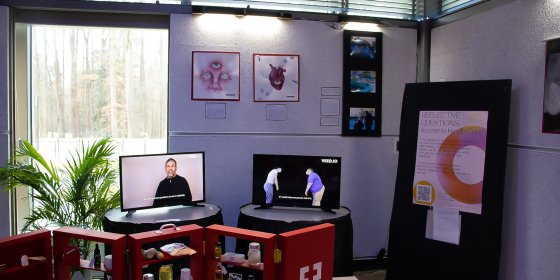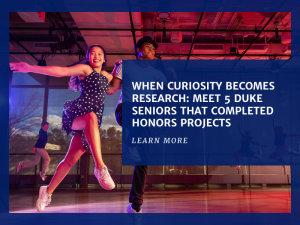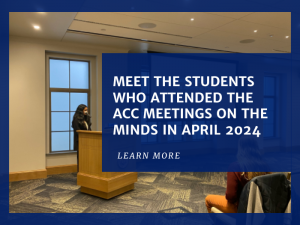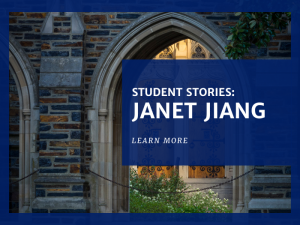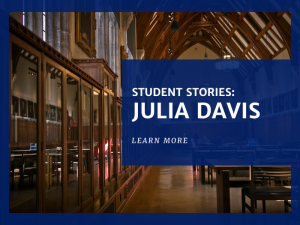Art, Fear, and Healthcare: Exploring Healthcare Literacy through the Visual Arts
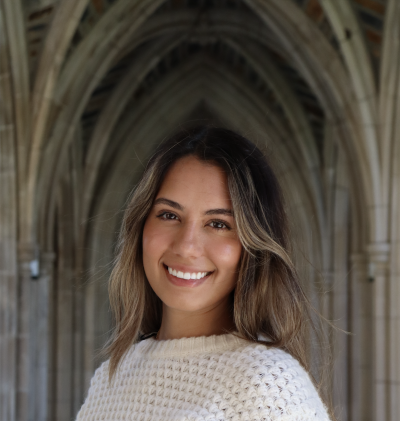
In Spring of 2022, Fatima Massare Somers '23 (Program II Major) received a Student Team Grant Award to examine how art can help promote self-efficacy for patients in healthcare settings. Her project, "Art, Fear, & Healing in Medicine: Exploring Health Literacy & Empowerment through Visual Narratives", investigated how art can generate conversations about patients' fears and perceptions of healthcare. With the support of mentor Wesley Hogan, Director of Center of Documentary Studies, Fatima and her team facilitated group discussions after a documentary showing, as well as prompting unfacilitated conversation through a visual arts exhibition.
By Fatima Massare Somers
Getting told that your body isn’t in perfect condition is an innately scary thing - especially if you don't immediately understand what the diagnosis means, what your next steps are, or how serious it is. As a student on the premedical track, this phenomenon, the lack of conversation about it, and how little has been done to fix it, baffled me. Therefore, I wanted to take advantage of my program of study to address this phenomenon in a new way.
As a self-taught artist, I’ve always found that I can express myself the best through what I create. During my time at Duke, I’ve noticed how effective art is in starting meaningful conversations and topics of investigation; I’ve studied works of art in almost every class I’ve taken, ranging from Jane Richardson’s depictions of protein structures in biochemistry to artistic reflections of illness, protest, and community in Global Narratives of Illness and Disability.
The US healthcare system is characterized by power dynamics between physicians and patients that contribute to healthcare avoidance, especially among college students, who face unique barriers such as fear and reluctance to display vulnerability. Efforts to improve health literacy are starting to deconstruct and address layers of unnecessary complexity through person-centered healthcare designs. The goal of my research was to elucidate the role of engaging with visual narratives of health experiences as a way to promote self efficacy and confidence in individuals to reduce healthcare avoidance or hesitation.
I recruited a team of colleagues with similar interests to investigate how to use visual art to my advantage for starting the conversation about patient fears and its effects on patient confidence. The academic program "Art, Fear, & Healing in Medicine: Exploring Health Literacy & Empowerment through Visual Narratives" was designed to investigate the extent to which visual arts can improve patient health outcomes by promoting honest conversations within communities that address patient fears of diagnosis/treatment and thus reduce hesitancies in seeking care.
These research questions were explored in two parts. In the fall of 2022, we held documentary screenings of The (In)Visible Organ, a documentary that shares stories of growth, pain, and beauty surrounding the inner reproductive anatomy, and facilitated group discussions afterwards. In the second part of the program, we created a visual arts exhibition showcasing experiences of and within medicine and health. Alongside the exhibit, attendees were asked to fill out surveys with reflective questions.
I found that participants left both programs feeling validated, informed, empowered, while also having developed an appreciation for visual narratives’ power to inform the health experience. This research presents novel approaches to improving the communication and empowerment of health information primarily for college students, the primary demographic of the study. Specifically, this research explores the effectiveness of using visual arts to make the healthcare process more engaging and enjoyable.
Through analyzing the impact of engaging with visual narratives of health experiences created by others, we demonstrate the significant potential of art in providing information, validation, and motivation for individuals in their personal health journey while also facilitating learning from others' experiences. Moreover, it offers insights on how to encourage discussions around health information and experiences that promote empathy and empowerment.
I presented this work at the Visual Connections Symposium and was granted Graduation with Highest Distinction in Program II for it. Moving forward, I am looking to publish this work in the Narrative Medicine Journal, Intima, as well as publish a virtual walk-through of the gallery.
